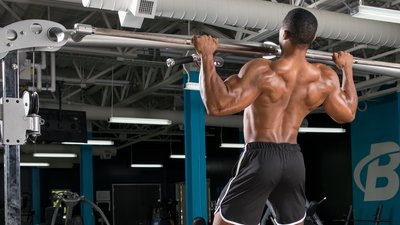Like they say in bodybuilding, "The show is won from the back." Judges expect bodybuilders to have sculpted chests and arms, so it's the person who pays attention to details in the back who stands out from the crowd. Size matters, too—big time. A small waist and wide lats might look great from certain angles, but if your back lacks thickness, you can lose valuable points when you do a full 180-degree turn.
Looks aside, a powerful back can prevent or speed recovery from injury, as well as improve your overall performance. If you're involved in sports, you need a thick back to make a better block in football, a stronger takedown in wrestling, and a more dynamic punch in combat sports.
In this guide, we'll give you a general overview of the muscles in your back, explain which exercises are best for getting rid of or preventing back pain, and which exercises engage which back muscles.
Anatomy Of The Back
Your back is made up of bones, joints, nerves, muscles, and connective tissues. All these parts work together to keep the vertebrae in your spinal column aligned. The spine itself is divided into three parts: the cervical spine at your neck, the thoracic spine in your mid back, and the lumbar spine in your lower back. Improper bending and twisting while lifting heavy weight can damage the discs between the vertebrae. To build a bigger back, you must maintain good posture throughout your day—not just when you lift weights.
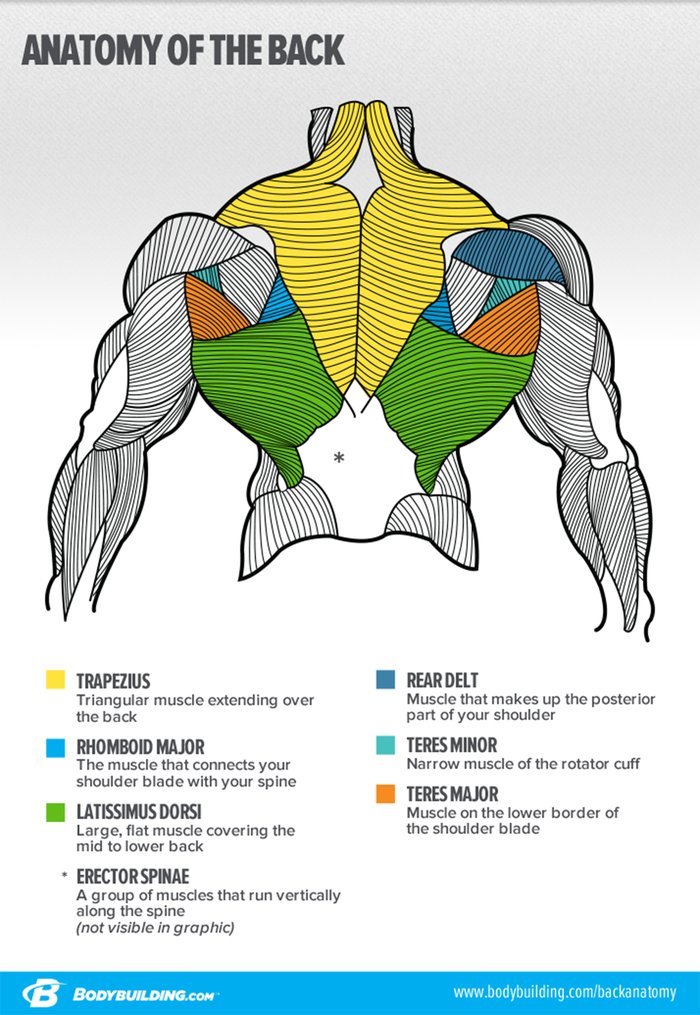
The muscles located in your back include the trapezius (upper back), rhomboids (upper back, underneath the trapezius), latissimus dorsi (widest back muscles), teres major/minor (underneath shoulder on your side), and the spinal erectors (such as multifidus and longissimus).
The muscles in the front of your body play a key role in back strength, too. The rectus abdominis (the six pack) and the oblique muscle (located on the side of your torso) stabilize the spine and help you lift, pull, and carry weights. Back exercises may recruit all or just a few of these muscles.
There will come a point in time where you're able to control the appearance of your lats, where you can stand up straight and spread them apart at will. This is generally when you know you've made significant back gains.
The King Of All Back Exercises
Many bodybuilding aficionados consider the deadlift to be the king of all exercises for the way it builds mass in your back and strengthens so many major muscle groups. When you're out to build a bigger back, the deadlift is your most important exercise.
The deadlift is a good teaching tool, too. Beginning lifters increase their overall strength not necessarily due to their deadlift rep schemes, but because of the improved neural efficiency that comes with learning how to move a heavy barbell through the deadlift range of motion. It is by teaching your central nervous system how to recruit each section of each muscle engaged in a deadlift that you build strength.
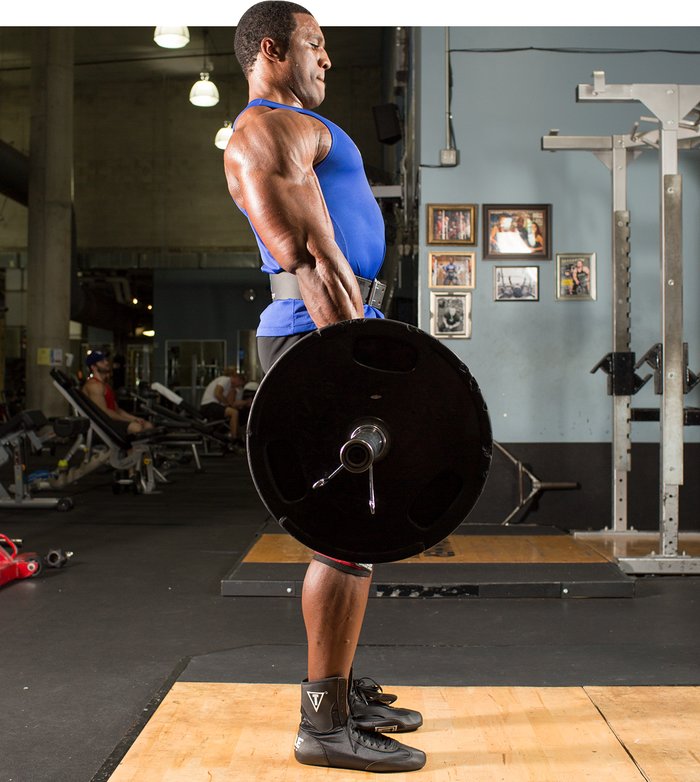
After you've been lifting for a while—long enough to hit plateaus deadlifting in the 1-5 rep range—it's time to start training for overall aesthetics. The ideal rep range for hypertrophy, or muscle building, is 8-12 reps with moderate weight. Moving into the 15-20 rep range, which of necessity means you'll be using lighter weights, will improve muscular endurance but not thickness.

More Free-Weight Back Exercises
You can also add mass to your back with barbell bent-over rows, single-arm dumbbell rows, barbell or dumbbell shrugs, and rear deltoid dumbbell flyes. Barbell bent-over rows target the lats, teres major, middle trapezius, rhomboids, and posterior (rear) deltoids. Do these rows on a back day when you're not deadlifting.
The single-arm dumbbell row targets the same muscle groups as the bent-over row and enables you to target each side of your back with moderate weight. Shrugs target the trapezius and rear deltoid muscles to give you a thicker upper back. Rear deltoid dumbbell flyes also target the upper back and, since you'll use light weights for this one, you can really improve the landscape of your upper back.
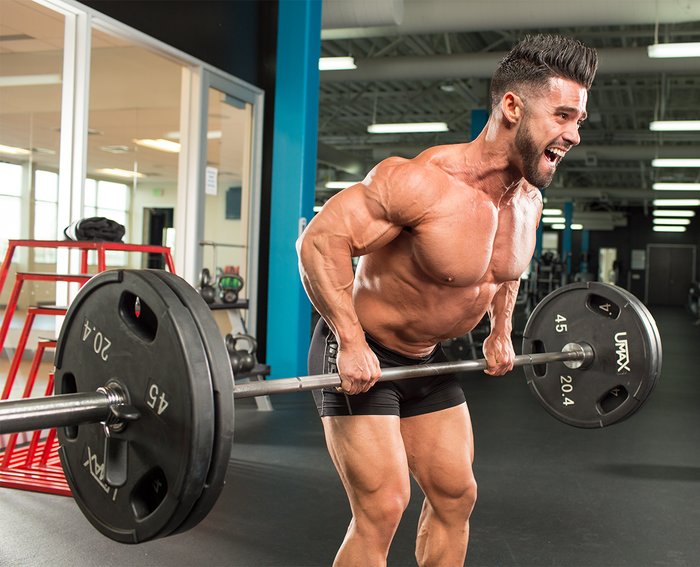
Machines Exercises For Back
Moving away from free weights, the lat pull-down, low-pulley seated row, and rear delt machine fly are machine exercises that target the lats, traps, rhomboids, and rear delts. Using a wider bar and grip for the lat pull-down and row machines can help increase the overall width of your lats. By using a narrow grip, you can increase your vertical range of motion, which can lead to added thickness of the entire muscle belly.
Using lat pull-down and row machines, both of which allow for single-arm variation, enables you to focus all of your efforts on increasing muscle size in one area at a time. A lesser known advantage to single-arm machines is the concept of negative training or eccentric training, where you increase the time spent or the actual weight lifted during the final portion of the rep.
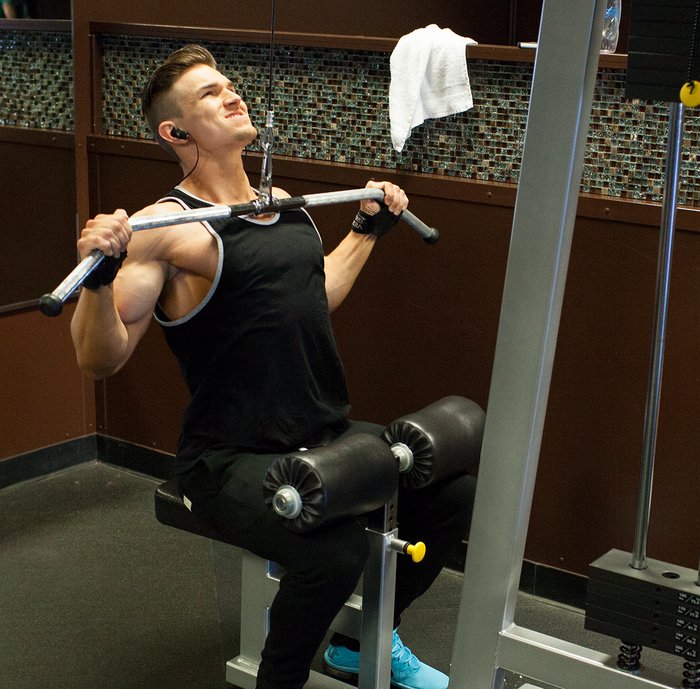
For example, if you're working on your lats by using a D-handle on a lat pull-down machine to convert it to a single-arm lat pull-down, set the weight stack to 20 pounds and pull it down with your right hand. Then, with your left hand, switch the stack to 40 pounds and return the weight back to the start. Move it back to 20 pounds for the concentric again and add the 20 pounds for eccentric (bringing the weight back to the top). By focusing on the second portion of the rep, you're stimulating muscle growth in a way your muscles aren't used to, resulting in faster gains.
Bodyweight Exercises For Back
If part of your quest for a massive back is to improve your performance, then what good is it to row a bunch of weight if you can't even move your body through space? Pull-ups, inverted rows, back extensions, and suspension-trainer rows are moves designed to build back strength and size in ways that engage your whole body instead of targeting a single muscle or muscle group. And you don't need to limit yourself to your actual body weight when you do these "bodyweight" exercises.
For instance, once you're able to do 3 sets of 10 pull-ups, increase the load by attaching a dip belt to your waist and looping a weight plate or kettlebell to it. If you can't do pull-ups, start with the inverted row and suspension trainer rows to learn how to stabilize your core as you move your body upward.
The bodyweight exercises bird dog, superman, dead bug, and plank can help prevent injuries and speed recovery from lower-back pain. They can also help you post injury to regain strength and stiffen core muscles to improve sports performance in terms of both endurance and strength. Do 2-3 sets for 10 reps of all four of these exercises in the beginning or middle of a back workout. Do them at home on rest days to add longevity to your lifting career.

